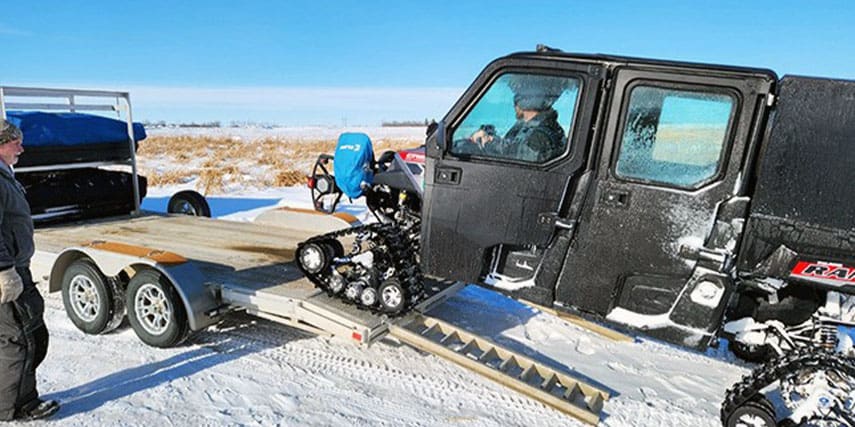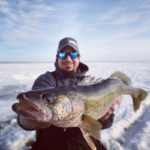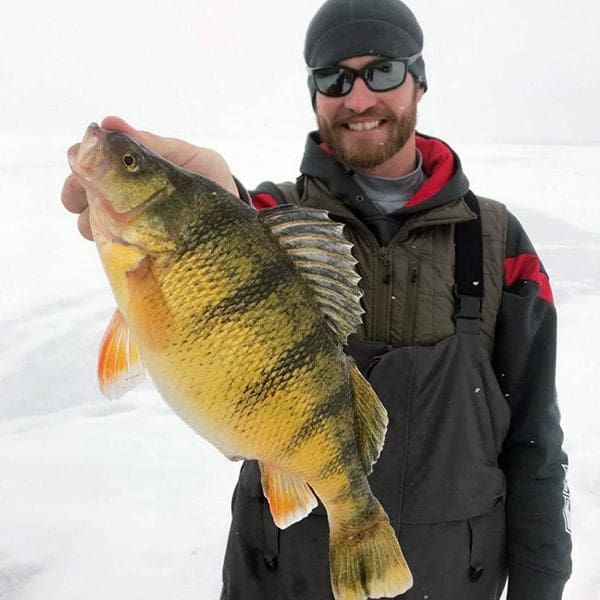200,000-acre-plus Devils Lake, North Dakota, is a fish factory—super fertile with freshwater shrimp, young-of-the-year perch and white bass, baitfish, insect larvae, etc. That means walleyes, perch, pike, and white bass grow fast and fat.
Spring, summer, fall, winter, Devils Lake offers incredible multispecies action. Come winter, the lake’s sag-bellied, golden jumbo perch reign supreme—which many anglers insist taste even better than walleyes.
Veteran Guide Talks Turkey about Devils Lake Perch
While many know Korey Sprengel as an acclaimed tournament walleye angler, he’s also a knowledgeable Devils Lake ice fishing guide who puts clients on messes of big perch – day-in and day-out.
“Perch are the most targeted species on Devils during winter,” says Sprengel. “But they can also be the most elusive. Perch don’t like to stay put, so mobility is key to staying on a good Devils perch bite.”
Sprengel says where perch are one day, they probably won’t be the next. And given North Dakota’s wind and weather, outside hole-hopping can prove difficult, so he’s constantly scouting and moving clients around in two-man flip-over shacks.
“Fishing out of flip-overs is also a plus because it seems like the bigger the perch are, the lighter they bite. You need to be able to see the slightest movement in your line, the rod tip, or spring bobber,” adds Sprengel.
Portable two-man flip-overs allow Sprengel and the Perch Patrol crew to spread clients out and cover more water. He generally guides four anglers, two in each house, while he moves around and tests water—anything from depths around sunken trees to featureless basins where perch just “cruise around.”
“The key is having someone that can scout, to find fresh schools, and get you in front of moving fish. Devils Lake perch are super competitive and travel in packs. That means it can be a waiting game, because once you get one fish to commit it usually creates a feeding frenzy with a few to a couple dozen other competing fish.”
Sprengel says when you find these perch packs and yank one, it’s important to draw in other anglers to capitalize. “You need to fish super-fast, never knowing if there’s three fish or an entire 40-fish limit.”
Watching electronics, it’s not uncommon to see a 15-foot deep band of roving perch looking to eat. Then it’s game-on and catching can be every drop of your spoon.
“You’ll often get in an area where big perch packs are moving through, and the key is staying put because the school won’t generally move far once you get a couple to bite. It energizes the entire pack,” offers Sprengel.

Perch Location Through Winter on Devils Lake
Early Season
Sprengel says that as of December 15th, Devils Lake has anything from open-water areas to other spots with 7- to 8 inches of ice.
“Devils is massive. It’s about 30 miles north by south and 50 miles east to west. And it’s broken up into a lot of bays, lakes, and smaller areas of water. This time of year, through mid-January you can find perch in submerged trees between 8 feet out to 20 feet,” volunteers Sprengel.
At the same time, Sprengel notes, walleyes can be found in as little as 3- to 5-feet of water in the upper lakes and some of the bays. “They can be super aggressive and an alternative to perch fishing.”
Mid- to Late Season
As winter sets in on Devils Lake and snow deepens, perch slide out to the edges of the old shoreline – before the lake flooded in the ‘90s, typically areas around 20- to 22-feet given the lake’s current water level.
“The old shoreline is the next location that fish move,” says Sprengel. “The perch will be just outside of where the old shoreline turns into mud in that 20- to 30-foot range.”
But Sprengel does say that midseason perch (and walleyes) can spread out.
“You could still have some perch in the trees in isolated areas, but you’ve also got fish moving out into 30-feet-plus water.”
Sprengel says that’s one of the unique things about Devils Lake. “There are portions of the lake that don’t have 20 feet and there are areas with 50 feet that don’t have much 20 foot water. The farther you go east, the deeper it gets; as you go west it shallows up where 20 feet might be the deepest, if not water around 10 feet.”
In all, he says different parts of the lake fire up at different times during winter.
“In the middle of January, you’ll get a super cold snap at some point where it could be a week to three weeks where it might be 10 to 15 below during the day with 30 below nights. The ice starts piling up and fish group up and slow down, congregating out in the mud basins in 35- to 50-foot depths.”
Sprengel says from the end of January through February perch schools become “tremendous and giant.” But the trick is finding thse schools. This time of year, says Sprengel, is “feast or famine.”
“It can be really frustrating fishing dozens of holes without marking a fish, but then you’ll find a big school or a school will move in.”
Some days Sprengel and crew will find fish by 9 am and fill limits; other days, you must move around for hours to find them. It’s all weather dependent.
“Once perch move out to the deep mud, high pressure can move them around. Those conditions keep the freshwater shrimp hidden and the perch roam around hungry. On cloudy, dark days, the shrimp are more active and the fish just stay put on the food.”

Two Key Perch Presentations
Sprengel says you only need two presentations to catch winter jumbos on Devils Lake.
“An 1/8th-ounce rattling spoon of some sort is a must-have,” offers Sprengel. “You drop it down fast, get their attention, and a lot of times perch will shoot up from great distances to eat it. I usually tip the treble with a minnow head or waxworms.”
But sometimes the perch are a bit wary, and you can use the rattle spoon to call them in, but they want something more finesse-oriented. That’s when Sprengel pulls out a 5mm tungsten jig tipped with a bunch of waxworms or spikes.
“Especially when you start getting into those deeper fish, they can be a little picky, and the tungsten jig is key.”
Often, though, you can get them to fire up with the tungsten and then fish faster with the spoon after the perch school has reignited.
Dress for Devils Lake Conditions
Thinking about hiring Korey or any of the numerous Perch Patrol guides who operate out of Woodland Resort? Better bring the right apparel to stay warm.
For Sprengel, that means the following:
- Base layer: Merino wool long underwear top and bottom
- Sweatpants over base layer
- Whitewater Fishing Buoy hoodie
- Whitewater Fishing Torque heated vest
- Ice fishing bibs
- Warm Merino wool socks/boots rated for temperatures below zero

